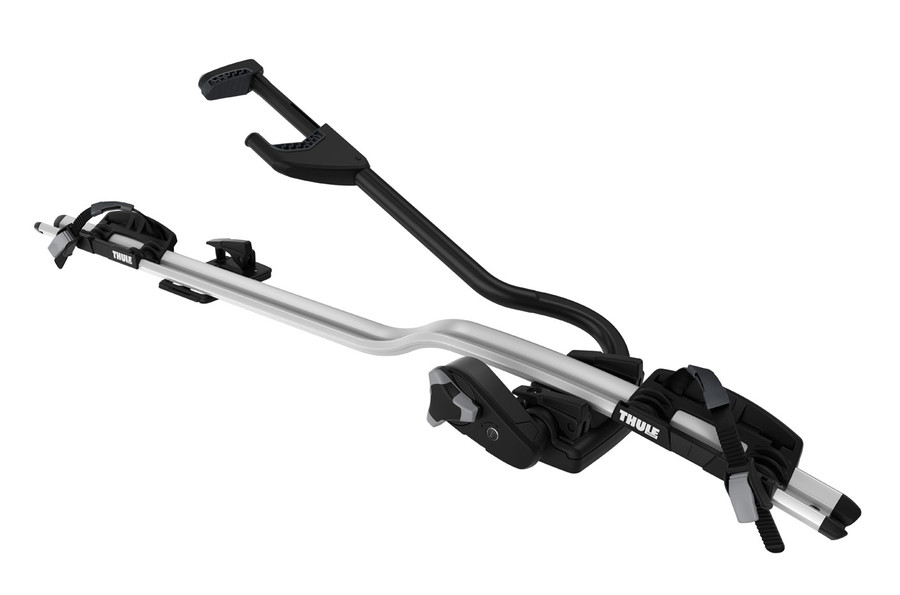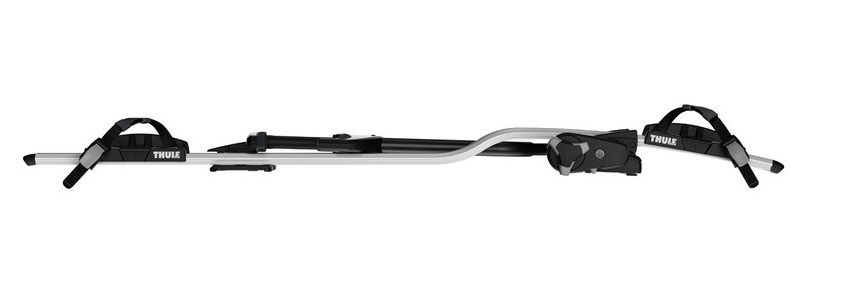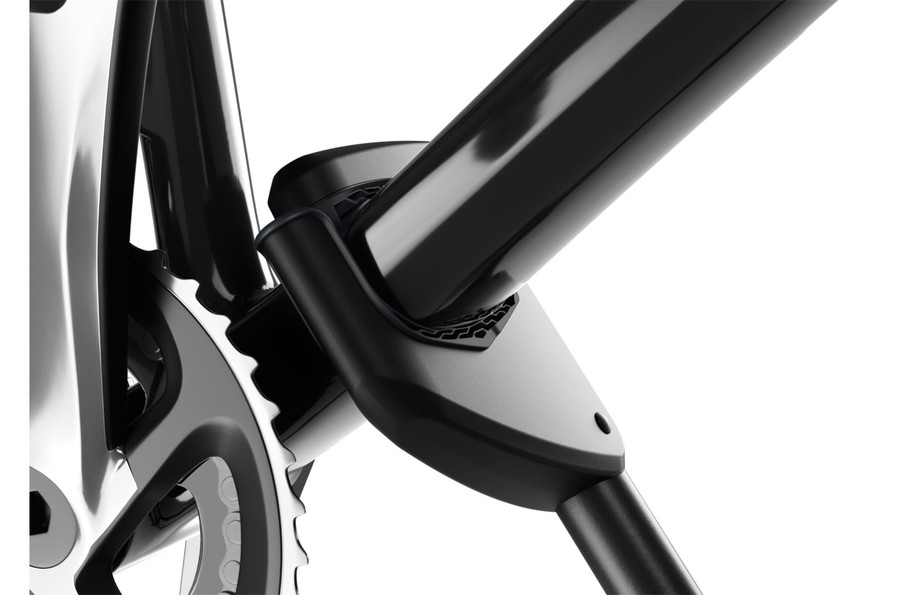Thule ProRide roof mounted bike carrier review
Carrying a bike on the outside of your car is essential if you're also transporting lots of luggage or people. The Thule ProRide offers a solid and secure option for bike transportation that is quick and easy to use.

A very well made bike rack that is as quick to use as putting your bike in the boot. It's reassuringly solid, unlike many boot mounted racks and doesn't encumber parking like a tow bar mounted rack. It's solid and secure and can be left in place when not in use without noticably affecting your cars performance.
-
+
Quick and easy to get a bike in place
-
+
Holds bike securely in place
-
+
Can stay in place on car roof without adversely affecting fuel consumption
-
+
Keeps bike and it's dirt outside of the car
-
+
Can be secured in place
-
+
Doesn't affect access to car boot or restrict driver's visibility
-
-
Gets expensive if carrying more than one bike
-
-
Tyre straps can get in the way when mounting the bike
-
-
Need roof bars before you can fit it
You can trust Cycling Weekly.

I’ve spent years transporting bikes in the back of a car, usually whipping out the front wheel, throwing an old grease stained fleece blanket over it and slamming the boot shut before heading off. Bags would be placed carefully around it of course and it took a little more finessing if I was taking a friend and their bike. But I became fairly adept at balancing bikes on top of each other - separated by blankets - and avoiding any damaging movement.
Transporting a bike in the car keeps it largely out of sight, doesn’t affect fuel consumption, it’s quick and there’s never any danger of it falling off or out. I still have memories of family holidays, looking nervously back at my beloved Specialized Rockhopper wobbling about on the boot mounted bike rack of my Dad’s car.
A bike rack however is the only option if you need to fill the boot with bags or have other people in the car so can’t flip the seats down – family holidays a case in point. There’s also a strong argument for roof racks when your bike is filthy. If want to keep the inside of your car clean, a rack is of course the best option.
If I’m going to use a rack, even when the boot is empty, it has to meet a few simple requirements.
- Mounting the bike has to be as quick and easy as putting one in the boot.
- It has to be secure enough to not leave me stressed the whole drive, thinking ‘is it about to fall off ?’
- It shouldn’t restrict access to the boot or visibility

There are a few other things that are important to me, and no doubt many of you will have your own requirements depending on car and lifestyle. I for example like a rack that won’t take up much space when off the car – which pretty much rules out boot or tow bar mounted racks. I’d also rather leave it in situ for most of the time due to the amount of use.
The ProRide meets requirement number three no problem and is no problem when left in situ. Thule do advise you take it off when not in use as it will affect your fuel consumption. But I found it to be negligible, happily staying around 62-64 mpg on long motorway drives. With a bike on it typically dropped to nearer 60mpg, but this number is affected more by the way you drive than having a bike on the roof.
Before using it you do of course have to fit it and before you can do that, you have to have roof bars in place to attach it too. I already had a set of Thule Wing bars on my car meaning compatibility wasn’t an issue. The ProRide will fit to all Thule bars, and other manufacturer’s roof bars, with the Thule adapter kit (available separately).
Fitting the ProRide was pleasingly simple. I’d prepared myself for a long and frustrating afternoon of shouting at the instructions booklet but instead had it all in place in less than 15 minutes. Once the T-screw is in place (in the roof bars) you simply slide the two base plates in to position, feed the T-screw through the holes in the base plate and clamp them down with the cam levers. One of which is locked in place so the whole system can’t be taken off without the provided key.
There is plenty of forward and back movement in the base plates to ensure they sit on your roof bars wherever you’ve placed them on your car. I wouldn’t want to keep taking it on and off every time I used it but it’s not a major operation to remove it.
There’s not a bit of movement once the whole system is in place. Wobbling the roof rack will move the car on its suspension rather than move the rack; which filled me with confidence even before I’d put a bike on it.
Next up was the acid test. Getting the bike in the rack. This does feature in the instructions, but as a man I felt duty bound not to read them. As editor of a cycling magazine, I was pretty damn sure I could get a bike on a bike rack without reading instructions.
I’ll admit that my own cackhandedness meant I was fumbling around for several minutes on my first attempt, but once I’d done it a few times I found the right order of actions which sees me getting a bike in and out in little more than 20 seconds. Here are the steps for getting the bike in.
- Undo the quick release wheel straps and tuck them behind the wheel mount
- Open the frame clamp and raise the arm to approximately 30 degrees, or where your downtube is going to meet it (doesn’t need to be exact)
- Standing on the ground (not on the rear door seal) lift the bike by the seat stay and fork and place tyres in the wheel mounts. These do slide back and forth if needed.
- Pivot the bike on its tyres so the downtube sits between the two parts of the clamp, leaning it against the back of the clamp.
- Holding on to the rear seat stay tighten the clamp (it takes a few turns) ensuring the downtube sits snug in the centre of the clamp.
- Tighten the straps over the rims ensuring the rubber guards are over the rim. (You might just need to rotate a wheel to move a spoke out of the way.)
Once it’s in place you can lock the clamp to secure the bike. You don’t have to lock it to keep it closed, just to prevent anyone else from opening it. For anyone to steal it once this is locked they would need some serious equipment to break the clamp arm or the clamp itself. The times I did leave it unattended I ran a lock through the system just in case.

I used the rack with a standard road bike and a mountain bike with a big chunky downtube, both were clamped snuggly in place as the rubber lining of the clamp moulds around the tube whatever its shape. We got the quick release wheel straps over a set of Cannondale Knot 64mm deep section wheels and there was plenty of strap to spare. The design of the mounts also means any width of tyre will fit with the possible exception of fat bikes.

The one addition I’d like to see made to this is a clip to hold the wheel straps out of the way when putting the bike in place. You can tuck them behind the wheel mount, but I found they would often flip back over and get in between the tyre and the mount meaning you had to put the bike down, tuck the strap out of the way again before picking the bike up to put in place. Not a big deal, just mildly annoying.
One thing to consider before buying is the number of bikes you want to transport. The advantage of most boot mounted racks is that they’ll take multiple bikes (usually up to four), if you want to use the ProRide, you’ll need to buy more racks which will put the price up considerably.
That aside, there are no complaints from me. The aluminium throughout the system is cleanly cut and neatly finished. All fixings are precise and feel solid, it’s secure, doesn’t impinge on normal car use and above all, it’s easy to use.
Just remember one thing. Always, always look out for height restriction barriers and avoid multi storey car parks at all costs.

Thank you for reading 20 articles this month* Join now for unlimited access
Enjoy your first month for just £1 / $1 / €1
*Read 5 free articles per month without a subscription

Join now for unlimited access
Try first month for just £1 / $1 / €1
Get The Leadout Newsletter
The latest race content, interviews, features, reviews and expert buying guides, direct to your inbox!

Editor of Cycling Weekly magazine, Simon has been working at the title since 2001. He fell in love with cycling 1989 when watching the Tour de France on Channel 4, started racing in 1995 and in 2000 he spent one season racing in Belgium. During his time at CW (and Cycle Sport magazine) he has written product reviews, fitness features, pro interviews, race coverage and news. He has covered the Tour de France more times than he can remember along with two Olympic Games and many other international and UK domestic races. He became the 130-year-old magazine's 13th editor in 2015.
-
 'This is the marriage venue, no?': how one rider ran the whole gamut of hallucinations in a single race
'This is the marriage venue, no?': how one rider ran the whole gamut of hallucinations in a single raceKabir Rachure's first RAAM was a crazy experience in more ways than one, he tells Cycling Weekly's Going Long podcast
By James Shrubsall Published
-
 Full Tour of Britain Women route announced, taking place from North Yorkshire to Glasgow
Full Tour of Britain Women route announced, taking place from North Yorkshire to GlasgowBritish Cycling's Women's WorldTour four-stage race will take place in northern England and Scotland
By Tom Thewlis Published
-
 Positive signs for UK bike industry as Halfords cycling sales grow
Positive signs for UK bike industry as Halfords cycling sales growRetailer admits that the impact of Donald Trump's tariffs remains to be seen
By Tom Thewlis Published